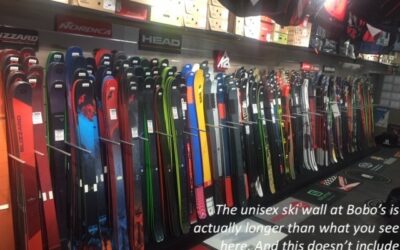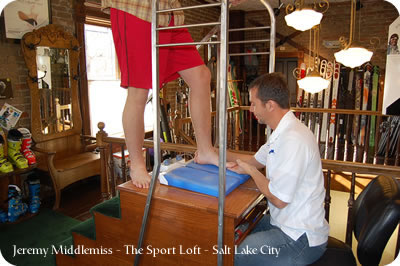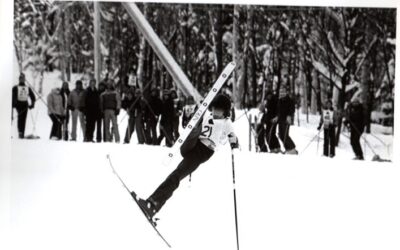
Since AI first reared its ugly head, I’ve been keenly observing its progress as a ski review creator (https://realskiers.com/revelations/chatgpt-ai-has-ski-patter-down-cold/) with a sense of impending doom. My second peek at its progress, The Con is On!, was one of the most read Revelations of last season, an indication that many of my Dear Readers share my curiosity about AI’s infiltration of our little world.
Now that AI has had another season to sharpen its skills, I thought it might be illuminating to check in on its evolution. Here’s what I discovered.
While AI remains a formidable mimic, and gets enough facts right to dupe those with little prior knowledge of ski attributes, it has several glaring tells that tip its hand. Its biggest shortcoming is that its bottomless appetite for data hasn’t quite caught up with the present day. When asked to compose a 300-word review of the 2025 Blizzard Anomaly 94, it didn’t flinch, but nor did it have a clue what characteristics the ski did or didn’t possess. It wasn’t even sure if the Anomaly 94 was a ski or snowboard.
Not that this deficiency slowed it down. It still whipped out a review in less time than it will take you to digest this sentence. It peppered its piece with the usual hyperbolic claims, like “revolutionary design,” “advanced damping technology,” and “lightweight yet sturdy.” AI’s specialty is evasive twaddle that sounds meaningful without depending on any actual facts: “hybrid camber profile,” “premium materials,” and “advanced damping technology” all pretend to mean something but are actually information-free.
When prompted to create a 300-word review as if I had written it, AI fumbled badly, writing the usual tripe about a mythical “XYZ” model, an open admission that it doesn’t need to know the model name – or anything else of a remotely factual nature – about a ski to write expertly about it. The review was such a vaporous botch that I decided to give AI another swing at the pinata, so I asked for another, Realskiers-style review. (If you’d like to hear what AI wrote for me this week in its entirety, I’ve recited them all in this week’s podcast.)
This time AI swung even more wildly, digging up a hypothetical snapshot of the 2022 Atomic Redster S9 FIS GS [sic], its name a heady blend of both Atomic’s Slalom and GS Race skis. Even if such a ski existed, I wouldn’t have reviewed it/them, as I’d (regrettably) dropped Non-FIS Race skis from coverage some years prior. Hard for AI to craftily imitate what it can’t find and/or never existed.
But AI has an admirable “can-do” attitude about it. Undaunted by its stumble out of the gate, the software rallied and extolled the virtues of what sounds like one terrific ski: “The Redster S9 FIS GS is a true powerhouse on the slopes, thanks to its Titanium Powered laminate construction that delivers a smooth and stable ride at high speeds. The ski’s Servotec technology enhances agility and control by dynamically adapting to the skier’s input, allowing for effortless turns and precise handling through variable snow conditions.” It reads like a perfect recipe for Word Salad: take two capitalized features, one inflated claim and a soupcon of benefits of fuzzy prominence; toss lightly without irony, and serve.
Oh, and good luck with the variable snow conditions on an Atomic race ski.
The AI bot I worked with was on more confident footing when contriving a review of a mainstream ski of its own choosing, as if written by a digital magazine writer/editor. It chose the Blizzard Bonafide, giving it an enormous archive to digest and regurgitate, given the Bonnie’s longevity and sustained popularity. The review would have helped its credibility if it hadn’t called the Bonafide “all-new,” but let’s not quibble. The software wanders away from its strong suit with such babble as, “the Blizzard Bonafide sports a sleek and modern look that is sure to turn heads on the slopes.” And its prosaic prose vacillates between hyperbolic panting and breathless awe. If this sounds like some of the dreck you read online, it’s because it was born in the primordial soup of the thousands of reviews it has absorbed into its DNA.
To be fair, AI lends itself to editing and re-writes, so some errors in its first drafts are readily righted. While it doesn’t hesitate to compose a review about a ski it knows nothing about, these more fanciful efforts (like the one on ski XYZ) can also be tweaked to create a more plausible product. One glaring omission in any AI-generated review is the absence of quotes from humans, perhaps a rare instance of concern about plagiarism and AI’s unblushing theft of other people’s work. Since the truth is never of much interest to AI, I don’t see why it would hesitate to create quotes from whole cloth.
The real danger of AI doesn’t lie in the larcenies and follies it commits on a daily basis, but in its inexorably expanding knowledge and sophistication that no one seems willing or able to check. Fabricating misleading ski reviews strikes me as the least of our worries.
Related Articles
The Savvy Shopper: How to Buy Skis
Let’s begin with a recap of the fundamentals.
Realskiers’ model selection methodology starts by dividing the Alpine ski market into seven categories, using waist width as the organizing principle for three excellent reasons:
1. This dimension is the single best indicator of the ski’s capabilities.
2. Waist width is a hard number, not a fuzzy concept like skier type.
3. Suppliers product lines align with this method, creating models in every category according a coherent pricing logic.
How It Works.
Why You Should Buy From People Who Know What They’re Doing And Have Your Best Interests at Heart Everyone wants a deal. So here’s the deal: every authorized dealer in the US signs a Dealer...
In Praise of the Wandering Mind
This subject has been percolating in the subterranean strata of my noggin for several months, searching for the connections that will lend it substance. The search for this topic’s handles has a wedding-cake’s worth layers: to depict the wandering mind requires its engagement, a self-cancelling concept that would oblige me to catch and release the idea in a Sisyphean quest to define its merits.
The notion of expounding on this Möbius strip of an idea was, naturally, an example of the wandering mind in action. I might have been noodling on a question several of my Dear Readers have posed, which can be distilled to, how did I ever learn to write in the manner that I do?
To find my answer, I had to relax my grip on the subject. My reasoning self was ready with mechanical answers, such as the discipline of writing every day. Duly noted, but insufficient. Let’s wander a little further.





